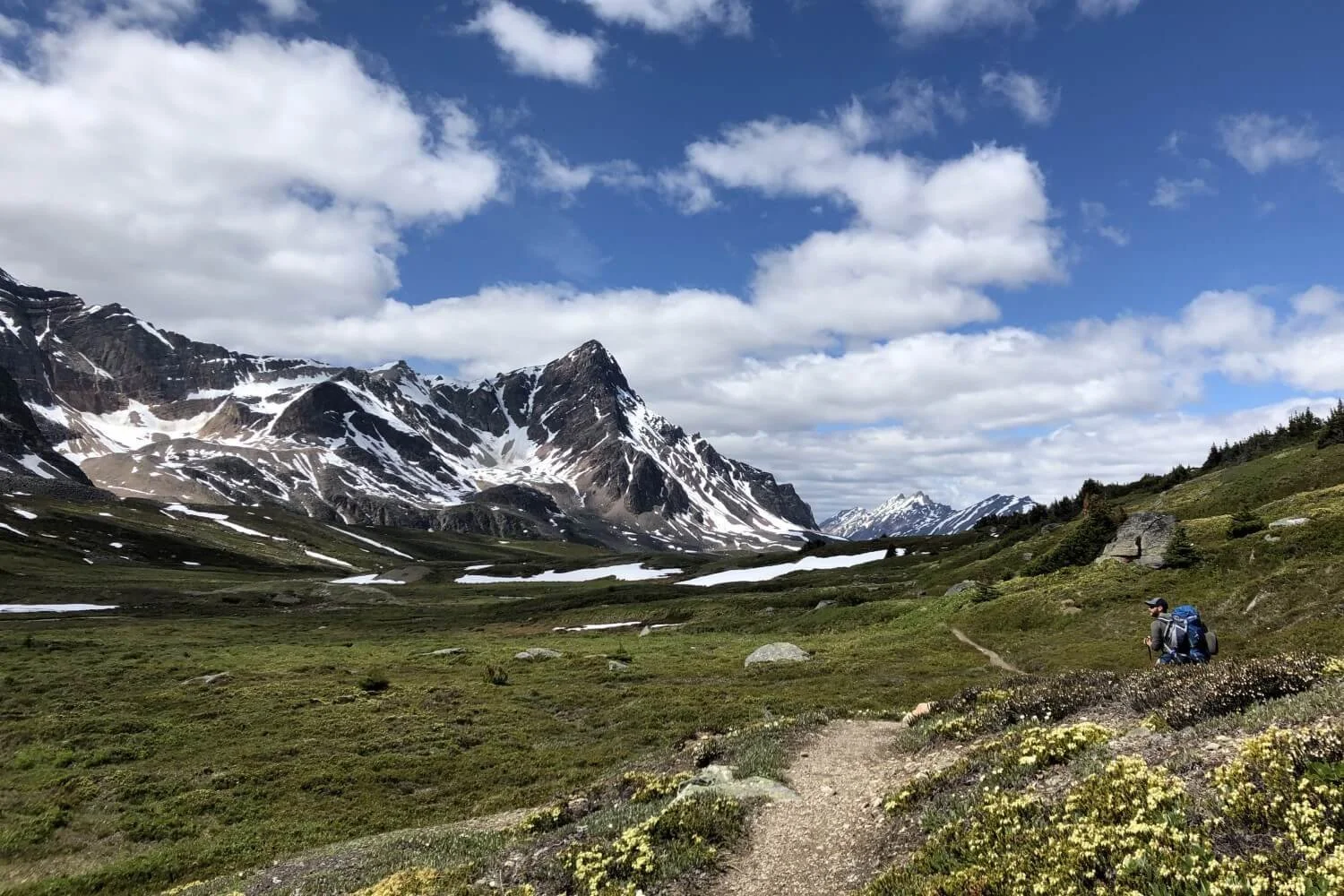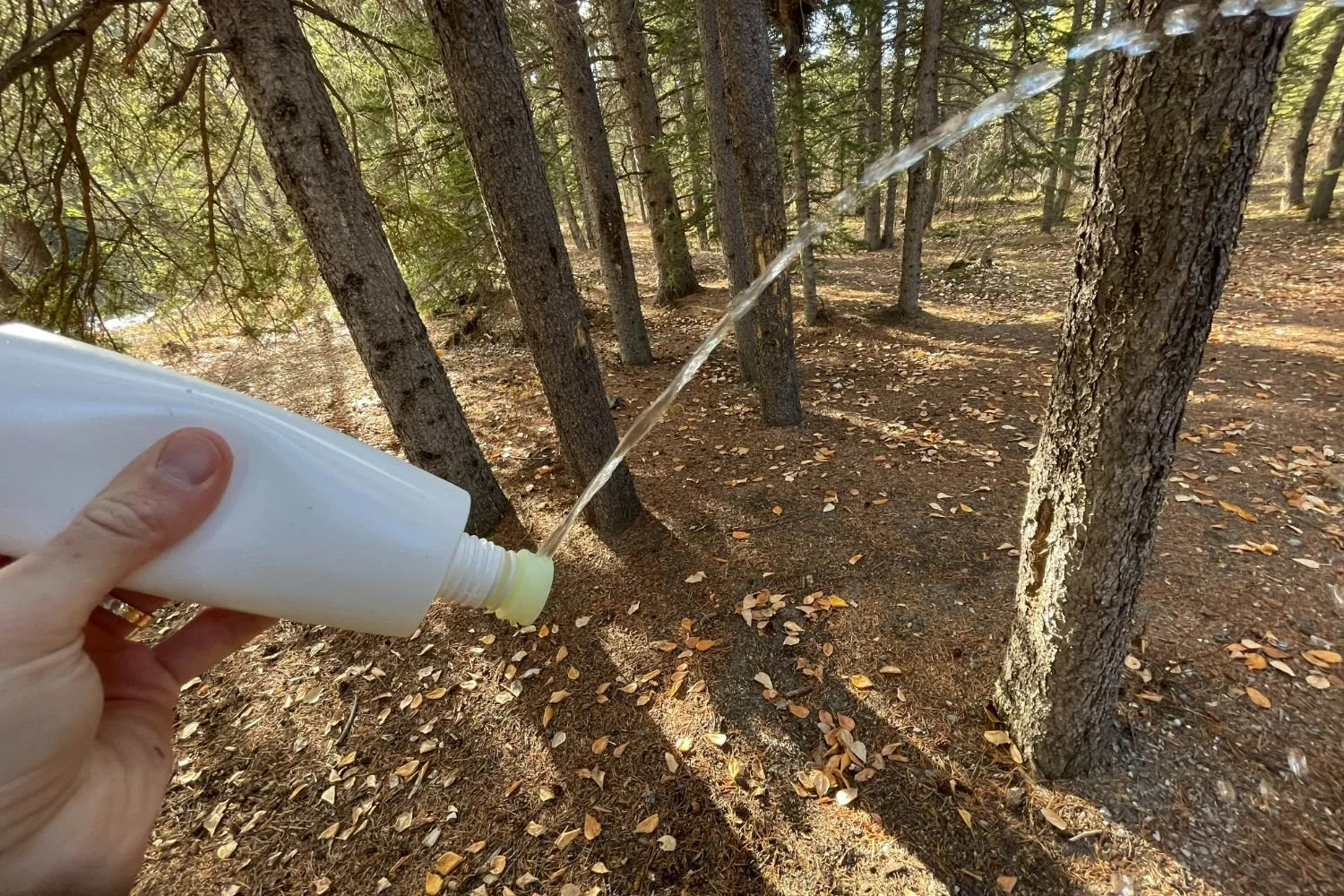The Ultimate Guide to Leaving No Trace in the Backcountry
JUMP TO: WHY LEAVE NO TRACE MATTERS | THE 7 LEAVE NO TRACE PRINCIPLES | ULTRALIGHT WAYS TO LEAVE NO TRACE | SUMMARY
Author: Steve Edgerton | Updated: Jan 4, 2024
We may earn a commission when you buy through our links. Learn more.
Keeping our backcountry areas wild and pristine is a core belief of just about every backpacker. This mindset, now taken for granted, was initially encouraged and cultivated thanks to the Leave No Trace (LNT) philosophy: a framework to help backcountry users how to tread gently—conserving fragile ecosystems and beloved wild places for future generations to enjoy.
This Guide to Leaving No Trace in the Backcountry summarizes the key principles constituting the LNT framework to illustrate what LNT backpacking looks like in practice. We also share our favorite low-impact strategies and gear choices that have the added benefit of being low-weight as well.
But these Leave No Trace strategies are not just for dedicated ultralighters and thru-hikers: they benefit every backpacker seeking to travel lighter on the planet and on themselves. Regardless, understanding how LNT principles apply to any backcountry adventure can help us all become more effective stewards of the parks and trails that sustain us.
Responsible use of the backcountry means that our departure should leave little memory of us ever having been there. Photo taken in Nelson Lakes National Park, New Zealand.
WHY LEAVE NO TRACE MATTERS
Participation in backcountry activities continues to grow exponentially. That is certainly not a bad thing: we love seeing more folks get outside and discover the life-changing potential of hiking and backpacking. But ironically, we’re beginning to love our wild places to death.
Increased traffic in parks and campgrounds often increases littering, trail erosion, wildlife habituation, water pollution, and human-started wildfires. This all serves to stress already delicate ecosystems and degrades the backcountry experiences for future users.
With more people on the trails, we all have a responsibility to be more responsible and mindful of our impact. And we can do that by following the 7 key LNT principles.
THE 7 LEAVE NO TRACE PRINCIPLES
The 7 LNT principles were formalized in 1994 with the creation of an official LNT organization in the US. These principles guide the mandate of land use managers and educate visitors about what responsible backcountry use looks like in practice. Since then, the LNT philosophy has been adopted throughout the world.
The principles are often adapted to the specific context of any backcountry area, but the core concepts remain the same.
PLAN AHEAD AND PREPARE: Having all the appropriate gear for the trail conditions will keep you safe and prepared to travel in ways that minimize your impact.
TRAVEL AND CAMP ON DURABLE SURFACES: Stay on the trail and set up camp in designated areas to reduce trail braiding, erosion, and trampling of delicate backcountry flora and fauna.
DISPOSE OF WASTE PROPERLY: Pack out all of your trash and uneaten food. No exceptions. Your sh*t can (usually) stay behind but use designated outhouses or be prepared to dig a cathole. Catholes should be 6-8 inches deep and located at least 200 feet from water sources, campsites, and the trail. Toilet paper must be packed out.
If you are heading into the backcountry you’ll likely need a backpacking trowel to ensure you can dig a cathole when nature calls.
LEAVE WHAT YOU FIND: Take only photos. Leave wildflowers, rocks, and other natural wonders for everyone else to enjoy too.
MINIMIZE CAMPFIRE IMPACTS: Wildfires are devastating wilderness areas worldwide, and they are only becoming more intense and frequent. Many of these fires are human-caused and easily preventable. Always follow local restrictions and fire bans and think twice if a fire is really necessary. Use designated fire rings whenever they are present and thoroughly extinguish your fire. Your fire isn’t out until you can safely touch the ashes with your bare hands.
RESPECT WILDLIFE: No, getting within 5 feet of a bull moose is never worth the Insta-worthy photo. Give all wildlife a healthy amount of space. Never intentionally feed wildlife. Store your food correctly to ensure you never unintentionally feed wildlife, either.
BE CONSIDERATE OF OTHER VISITORS: This is essentially the Golden Rule applied to backpacking. Don’t leave a mess for others to deal with. Don’t bring a stereo or be obnoxiously loud at camp. Don’t let your dog roam off leash. Do your small part to ensure everyone can enjoy the great outdoors equally.
You’ll want to ensure that you don’t unintentionally feed wildlife, or attract unwanted guests – in bear country a quality bear bag is generally a suitable way to store your food.
ULTRALIGHT WAYS TO LEAVE NO TRACE
LNT is not only about your responsibility as a backpacker. You can use these principles to inform your own trips, opting for gear and systems that are low impact and low weight. You can waste less and enjoy your backpacking trips more thanks to a lighter pack. What’s not to like about that?
Low Waste = Low Weight
“Pack it in, pack it out” is perhaps the most memorable and oft-repeated tenet of the LNT principles. This includes pretty much everything: food packaging, toilet paper, and uneaten leftovers. So, naturally, the less waste products you pack in, the less you have to pack out. Zero waste means zero weight and less stuff that will ultimately end up in a landfill.
Here are our favorite strategies for reducing waste and pack weights simultaneously.
MAKE YOUR OWN MEALS: A food dehydrator is one of the best backpacking investments you can make. Crafting dehydrated meals at home is healthier, cheaper, lighter, and less wasteful than pre-packaged backpacking meals.
You can bulk pack all dehydrated meals in a single bag and rehydrate them right in your ultralight pot. Perhaps best of all, you’ll no longer have to cart around and toss out a dry sack full of pre-bought meal bags at the end of your trip.
BACKCOUNTRY BIDET: If you’ve never used a bidet, the idea of using one backpacking may be especially off-putting. But it shouldn’t be. With a bidet, you never have to pack out used TP. You also don’t have to worry about running out of the stuff, resorting to finding a benign looking leaf to finish the job.
That’s enough to sell us on the superiority of the bidet. Our favorite, the CuloClean Ultralight Portable Bidet, weighs no more than a generous wad of toilet paper. It is compatible with any standard threaded water bottle, produces no waste, and is endlessly reusable. Unless water is scarce, bidets are the most functional, hygienic, LNT, and ultralight way to sh*t in the woods.
BULK SNACKS: Reduce unnecessary packaging by shopping in bulk and making your own snacks whenever possible. Pack Bulk trail mix, pretzels, and candy in lighter plastic bags, which can at least be reused over several trips. Likewise, homemade and bulk packed energy bars and oatmeal reduce waste and save space in your pack.
A portable bidet is a great way to reduce weight and bulk — by not having to carry shitloads of toilet paper into the backcountry.
Low Impact Ultralight Shelters
It can be hard to envision something as transportable and transient as a backpacking tent having any sort of significant environmental impact. But the cumulative effects of backcountry shelters can leave quite a mark on the landscape.
You should always stick to designated tent pads or durable surfaces free of vegetation whenever possible. Unfortunately, these surfaces are often incompatible with ultralight non-freestanding tents, which require setting stakes into soft ground. But there are other ultralight and low-impact shelter options to consider.
FREESTANDING/SEMI-FREESTANDING TENTS: Freestanding and semi-freestanding tents require tent poles, trekking poles, or a combination of the two. Staking adds security, but unlike non-freestanding tents, they still function when staking is not an option.
Our guides to the best one-person and two-person backpacking tents feature the best ultralight freestanding/semi-freestanding tents and cover them in more detail.
BIVY SACKS: Bivy sacks are ultralight, packable, and extremely easy to set up on any surface. Other than full-on cowboy camping, the minimal footprint and stake-free setup of bivy sacks makes them perhaps the most LNT-friendly shelter.
A notable downside of bivy sacks is their claustrophobic design. They are best for shorter mountaineering and fastpacking objectives or to complement a cowboy camping or tarp shelter. But bivy shelters, like the Outdoor Research Helium, use one pole to operate more like a mummy-shaped tent. The added headspace and livability make bivy shelters a viable ultralight LNT shelter for longer backpacking and bikepacking trips.
HAMMOCKS: Hammocks are a fantastic LNT shelter, as they have no impact on delicate vegetation. Of course, they do require adequate tree cover to be set up. Just be sure to use “tree-saving” hammock straps to avoid damaging trees. Almost all backpacking hammocks will come with these included. You can check out the Leave No Trace guidelines for hammock camping for more tips.
The Big Agnes Copper Spur HV UL is one of our favorite freestanding tents, reducing the need for stakes in particularly hard or fragile ground.
Low Impact Gear
A lot of your backpacking gear is likely polluting backcountry land and water. It is invisible and unintentional, but it is happening. PFCs, microplastics, and non-biodegradable chemicals are the primary culprits.
PFCs: For the last several decades, gear from rain jackets to tent flies was made to be impressively water-resistant thanks to PFC-based DWR (durable water repellent) coatings. PFCs (perfluorocarbons) are extremely effective waterproofing agents, but at an enormous cost. These “forever chemicals” leach out over time to accumulate in waterways and soil, with potentially severe consequences to both humans and wildlife.
Outdoor brands have mostly acknowledged the serious threat of PFCs, but some are transitioning to alternatives quicker than others. Our guide to the most sustainable outdoor brands is a good starting point if you’re eager to invest in more environmentally friendly backpacking gear and apparel.
MICROPLASTIC POLLUTION: A recent study demonstrated how synthetic footwear and apparel are polluting wilderness areas with microplastics, which can accumulate in quantities that begin to negatively affect ecosystem functions.
Fleece garments are likely the most susceptible to microfiber shedding, but all synthetic fabrics do to some degree. Washing and caring for your synthetic apparel appropriately can help minimize microfiber shedding. Prioritizing natural fibers like merino wool and TENCEL can help avoid microplastic pollution, but come with a different set of environmental impacts to consider.
BIODEGRADABLE SOAP: If you do use soap in the backcountry, it must be biodegradable. Otherwise, it will bioaccumulate in water and soil just like microplastics and forever chemicals. Our guide to biodegradable soaps highlights the best ultralight and backcountry-friendly options, and how to use them responsibly.
SUMMARY
Ultimately, we should all strive to Leave No Trace by following the 7 simple principles. Leveraging ultralight strategies to reduce unnecessary waste (and weight), avoiding forever chemicals and synthetics whenever possible, and simply buying less stuff that we don’t really need can help us go even further. And, when the time comes to buy new gear, vote with your wallet by prioritizing brands committed to high-performing, environmentally friendly gear that aligns your backpacking with LNT principles.
To dive deeper into LNT and the environmental impact of outdoor sports in general, check out the rest of our Sustainability 101 series. We explore how gear choices affect the planet, and what you can do to minimize your impact to ensure future generations get to equally experience and enjoy the places we love so much.
MORE INFORMATION
Looking for more information on hiking and backpacking? Be sure to check out some of our other tips and gear reviews:
Or check out our entire Gear Reviews Page, our Knowledge Base Articles, or Destination Guides for more hiking, backpacking, and outdoors related content.
Happy hiking and take care out there in the wild!



